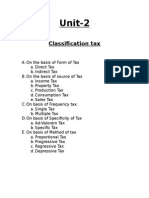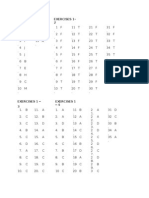Topic:-Direct and Indirect Taxes: Department of Electronics & Telecommunication Engineering
Uploaded by
Sakshi DewadeTopic:-Direct and Indirect Taxes: Department of Electronics & Telecommunication Engineering
Uploaded by
Sakshi DewadeG H Raisoni Institute of Engineering and
Technology, Nagpur
Department
of
Electronics & Telecommunication Engineering
(Session: 2021-22)
Topic :- Direct and Indirect Taxes
Presented by :- Sakshi Madhukar Dewade
Roll no.:- 05
Semester :- 5th
Subject: Engineering Economics and Industrial
Management
Direct Tax
A direct tax is a tax that a person or organization pays
directly to the entity that imposed it.
An individual taxpayer, for example, pays direct taxes to the
government for various purposes, including income tax, real
property tax, personal property tax, or taxes on assets.
Direct Tax
Direct taxes cannot be passed on to a different person or
entity. The individual or organization upon which the tax
is levied is responsible for paying it.
The Central Board of Direct Taxes (CBDT), which is
governed by the Department of Revenue, administers
direct taxes in India.
CBDT also contributes to the planning stages concerning
the implementation of direct taxes.
TYPES OF DIRECT TAX
1) Income tax
Income tax is a tax charged on the annual income earned by an
individual. The amount of tax paid will depend on how much
money you earn as income over a financial year.
Various tax slabs are determined by
the Government of India which
determines the amount of Income Tax
that must be paid. The taxpayer must
file Income Tax Returns (ITR) on a
yearly basis.
Income tax for FY 2020-21 applies to all residents whose annual
income exceeds Rs.2.5 lakh p.a. The highest amount of tax an
individual could pay is 30% of their income plus cess at 4% if
their income is more than Rs.10 lakh p.a.
TYPES OF DIRECT TAX
2) Wealth Tax
The tax must be paid on a yearly basis
and depends on the ownership of
properties and the market value of the
property.
In case an individual owns a property,
wealth tax must be paid and does not
depend on whether the property generates an income or not.
3) Estate Tax
It is also called as Inheritance Tax and
is paid based on the value of the estate
or the money that an individual has left
after his/her death.
TYPES OF DIRECT TAX
4) Corporate Tax
Domestic companies, apart from shareholders, will have to pay
corporate tax. Foreign corporations who make an income in India
will also have to pay corporate tax.
Income earned via selling assets, technical service fees, dividends,
royalties, or interest that is based in India are taxable.
The corporate tax also include Fringe Benefits Tax(i.e. Companies
that provide fringe benefits for maids, drivers, etc., Fringe
Benefits Tax is levied on them)
5) Capital Gains Tax
It is a form of direct tax that is paid due to the income that is
earned from the sale of assets or investments. Investments in
farms, bonds, shares, businesses, art, and home come under
capital assets.
ADVANTAGES OF DIRECT TAX
1) Economic and Social balance: The Government of India has launched
well-balanced tax slabs depending on an individual’s earnings and age. The
tax slabs are also determined based on the economic situation of the
country. Exemptions are also put in place so that all income inequalities
are balanced out.
2) Productivity: As there is a growth in the number of people who work
and community, the returns from direct taxes also increases. Therefore,
direct taxes are considered to be very productive.
3) Inflation is curbed: Tax is increased by the government during
inflation. The increase in taxes reduces the necessity for goods and
services, which leads to inflation to compress.
4) Certainty: Due to the presence of direct taxes, there is a sense of
certainty from the government and the taxpayer. The amount that must be
paid and the amount that must be collected is known by the taxpayer and
the government, respectively.
5) Distribution of wealth is equal: Higher taxes are charged by the
government to the individuals or organization's that can afford them. This
extra money is used to help the poor and lower societies in India.
DISADVANTAGES OF DIRECT TAX
1) Inconvenient:
The great disadvantage of a direct tax is that it pinches the payer. He
‘squeaks’ when a lump sum is taken out of his pocket. The direct- taxes are
thus very inconvenient to pay. Nobody can help feeling the pinch.
2) Evadable:
The assesse can submit a false return of income and thus evade the tax.
That is why a direct-tax is “a tax on honesty.” There is a lot of evasion.
Many of those who should be paying taxes go scot-free by concealing their
incomes.
3) Arbitrary:
If taxes are progressive, the late of progression has to be fixed arbitrarily;
and if proportional, they fall more heavily on the poor. Thus, both are bad.
The rate of taxes depends upon the whim of the Finance Minister. This is
arbitrary.
4) Disincentive:
If the taxes are too heavy, they discourage saving-sand investment. In that
case the country will suffer economically. A high level of taxation
discourages investment and enterprise in the country. It inflicts a lot of
damage, on business and industry.
INDIRECT TAX
Indirect tax is a tax that can be passed on to another
individual or entity.
Indirect tax is generally imposed on suppliers or
manufacturers who pass it on to the final consumer.
The burden of tax payment is on end consumer as they are
the ones purchasing the products.
Unlike direct taxes, these are
levied on materialistic goods.
Excise duty, customs duty,
and Value-Added Tax (VAT)
are examples of Indirect taxes.
TYPES OF INDIRECT TAX
1) Service tax
This tax is levied by an entity in return for the service provided
by them. The service tax is collected by the Government of India
and deposited with them.
2) Excise duty
When any product or good is manufactured by a company in India,
then the tax levied on those goods is called the Excise Duty. The
manufacturing company pays the tax on the goods and in turn
recover the amount from their customers.
3) Value Added Tax
Also known as VAT, this type of tax is levied on any product sold
directly to customer and are movable. VAT consists of Central
Sales Tax which is paid to the Government of India State Central
Sales Tax which is paid to the respective State Government.
4) Custom Duty
This a tax levied on the goods imported to India. Sometimes,
Custom Duty is also levied on products which are exported out
of India.
5) Stamp Duty
This is a tax levied on the transfer of any immovable property
in a state of India. The state government in whose state the
property is located charges this type of tax. Stamp tax is also
applicable on all legal documents too.
6) Entertainment Tax
This tax is charged by the state government and is applicable
on any products or transactions related to entertainment.
Purchasing of any video games, movie shows, sports activities,
arcades, amusement parks, etc. are some of the products on
which Entertainment Tax is charged.
7) Securities Transaction Tax
This tax is levied during the trading of securities through
Indian Stock Exchange.
Features of Indirect Tax
Tax liability: The service provider or seller pays indirect
taxes to the government, and the liability is transferred to
the consumer.
Payment of tax: The seller pays indirect taxes to the
government and the same is transferred to the consumer.
Nature: Indirect taxes were initially regressive in nature, but
thanks to the implementation of the Goods and Services Tax,
they are now pretty progressive.
Saving and investment: Indirect taxes are generally growth-
oriented considering the fact that they encourage consumers
to save and invest.
Evasion: It is difficult to evade indirect taxes because they
are now implemented directly through products and services.
Advantages of Indirect Tax
Convenience: Indirect taxes do not burden the taxpayer and are
convenient as they are paid only at the time of making a purchase.
Moreover, state authorities find it convenient to levy indirect taxes
because they are collected directly at the stores/factories which
helps in saving a lot of time and effort.
Ease of collection: Indirect taxes are easy to collect in comparison
with direct taxes. Since indirect taxes are only collected at the time
of making purchases, the authorities need not worry about their
collection.
Collection from the poor: Those who earn less than Rs.2.5 lakh p.a.
are exempt from income tax, which means that they do not
contribute to the government. Since indirect taxes are charged at the
point of sale, all individuals, regardless of the income tax slab under
which they fall, contribute towards the growth of the economy.
Equitable contributions: Indirect taxes are directly related to the
costs of products and services. What this essentially means that the
basic necessities attract lower rates of tax while luxury items are
charged at higher tax rates, thereby ensuring that contributions are
equitable.
Disadvantages of Indirect Tax
Indirect Tax charged sometimes are cumulative. This
means that in a point-based transaction system,
middlemen involved are likely to charge their own service
tax which may result in the overall price of the product
increasing.
Indirect Tax can be regressive in nature. For example, salt
tax remains the same for both poor and rich, However, if a
rich person defaults the payment, then the penalties
imposed will be higher as well.
Indirect Tax are not industry friendly. Taxes are levied on
raw materials and goods which in turn increases the cost of
production, thus not allowing industries to expand as their
competitive capacity is restricted.
THANK YOU
You might also like
- Direct and Indirect Taxes: Nature, Kinds and DifferenceNo ratings yetDirect and Indirect Taxes: Nature, Kinds and Difference12 pages
- Chapter 1 Introduction To Income Tax Act PDFNo ratings yetChapter 1 Introduction To Income Tax Act PDF66 pages
- Direct and Indirect Tax Merits and Demerits EconomicsNo ratings yetDirect and Indirect Tax Merits and Demerits Economics6 pages
- Indirect Taxes - Unit 1 (Part I) - 20-06-2021No ratings yetIndirect Taxes - Unit 1 (Part I) - 20-06-202111 pages
- Types of Indirect Tax Merits 33519b4adcc51ab523b0043855c65fe9No ratings yetTypes of Indirect Tax Merits 33519b4adcc51ab523b0043855c65fe94 pages
- TAX SYSTEMS AND VAT Roll (40,41,42,43,44,45)No ratings yetTAX SYSTEMS AND VAT Roll (40,41,42,43,44,45)11 pages
- Taxation: Compulsory Transfer of Money From Individuals, Groups or Institutions To The Government Indirect BenefitsNo ratings yetTaxation: Compulsory Transfer of Money From Individuals, Groups or Institutions To The Government Indirect Benefits21 pages
- Problems and Prospects of Direct Taxation in India: Macro-Economic Analysis For Rural Society' Assignment OnNo ratings yetProblems and Prospects of Direct Taxation in India: Macro-Economic Analysis For Rural Society' Assignment On45 pages
- Define Tax and Different Types of Taxes and Cannons of TaxationNo ratings yetDefine Tax and Different Types of Taxes and Cannons of Taxation7 pages
- Department of Electronics AND Telecommunication Department of Electronics AND TelecommunicationNo ratings yetDepartment of Electronics AND Telecommunication Department of Electronics AND Telecommunication8 pages
- Philippine Airline Vs CIR GR No. 198759No ratings yetPhilippine Airline Vs CIR GR No. 19875926 pages
- Accounts and Finance Manager Curriculum Vitae (CV) Harun RashidNo ratings yetAccounts and Finance Manager Curriculum Vitae (CV) Harun Rashid3 pages
- Historical Background of Taxation in Law of Taxation by Deepak TongliNo ratings yetHistorical Background of Taxation in Law of Taxation by Deepak Tongli32 pages
- E-Book On GST by CA. (DR.) G. S. Grewal - 2020No ratings yetE-Book On GST by CA. (DR.) G. S. Grewal - 202058 pages
- BIR - RMC.064-16.Tax Treatment Non-Stock Non ProfitNo ratings yetBIR - RMC.064-16.Tax Treatment Non-Stock Non Profit11 pages
- Impact of GST On FMCG and Automobile SectorNo ratings yetImpact of GST On FMCG and Automobile Sector43 pages
- Tax and Regulatory: Epc Contracts - Fiscal ScenarioNo ratings yetTax and Regulatory: Epc Contracts - Fiscal Scenario30 pages
- High Court Case Types and Their Full Forms100% (1)High Court Case Types and Their Full Forms56 pages





























































































